14 Fall-Blooming Perennials That Will Add Color To Your Autumn Garden
Autumn foliage sets the stage for these fabulous perennials that bloom in the fall.
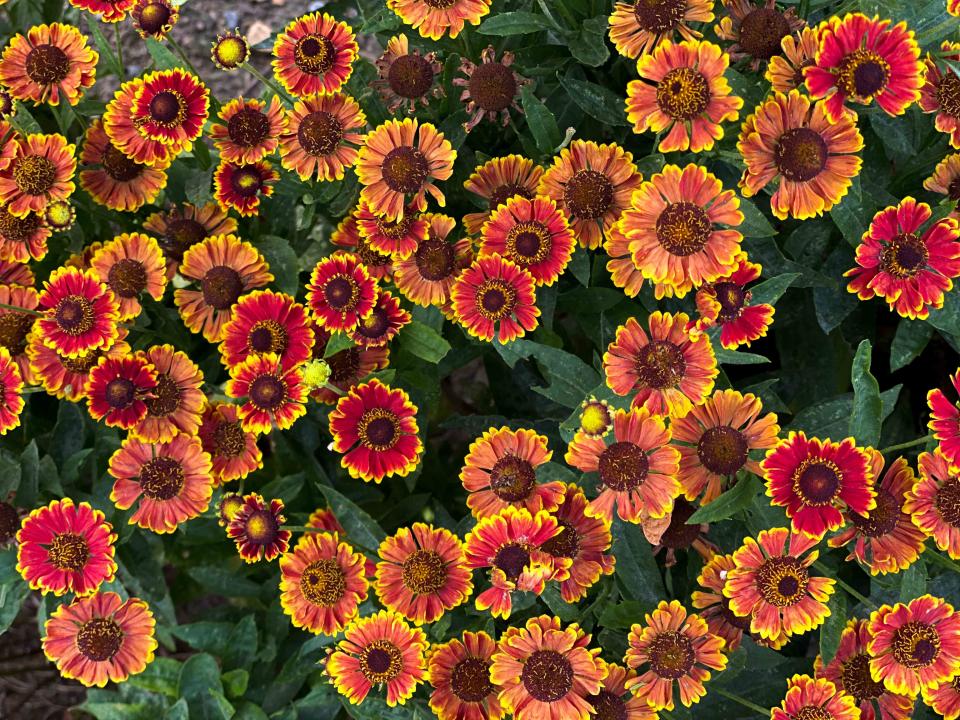
Getty Images / Catherine McQueen
Autumn does not mark the end of the growing season, there are still plenty of blooms to keep your garden looking fabulous. And fall is a great time to plant perennials. Stop by your local garden center—you are likely to find fall-blooming perennials overlooked during spring shopping.
Trees and shrubs tend to steal the spotlight in autumn as their foliage takes on radiant hues, but there is still plenty of color to be found in the flower garden. In fact, perennials that bloom in the fall can augment autumn leaves, drawing the color down to eye level. All those warm foliage colors provide the perfect backdrop for autumns blooms. Picture purple asters blooming against the jewel-toned foliage of stewartia. Or golden sunflowers set against a blaze of fiery sumac.
With these fabulous perennials that bloom in the fall, you can find the perfect blooms to pair throughout the autumn garden.
Hardy Chrysanthemum
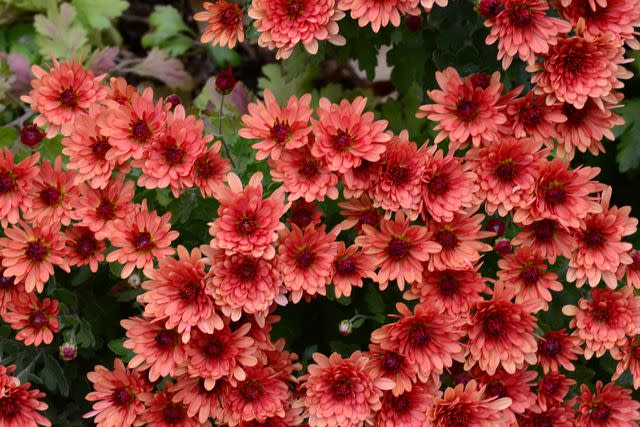
Getty Images / sjlayne
Botanical Name: Chrysanthemum (Rubellum Group)
Sun Exposure: Full Sun
Soil Type: Medium, Well-draining, Rich
Soil pH: Slightly Acidic to Neutral (5.8-7.0)
Though we often treat chrysanthemums or mums as disposable decorations, they are perennial plants. However, not all mums reliably return from year to year, especially in the southeast. The most dependable type of garden mums to come back and bloom each year belong to the Rubellum Group, often called hardy chrysanthemum, hardy garden mum, heritage, or old-fashioned mum. Pinch back the stems in spring or early summer as soon as the flower buds appear. This will encourage branching for denser growth and greater flower production, as well as delay blooming until fall.
Smooth Aster
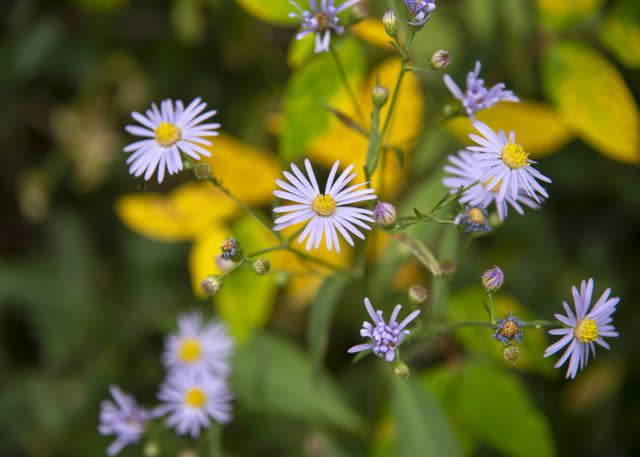
Getty Images
Botanical Name: Symphyotrichum laeve
Sun Exposure: Full Sun to Part Shade
Soil Type: Dry to Medium, Well-draining
Soil pH: Slightly Acidic to Slightly Alkaline (5.8-7.8)
This native perennial explodes into bloom September to October, with violet-blue to purple flowers covering plants. The flowers provide pollinators with an excellent source of nectar well into autumn, after which, songbirds feast on the seeds. Smooth aster makes a gorgeous companion to goldenrod, sunflowers, and other golden blooms. Plants are drought tolerant once established.
Narrowleaf Sunflower
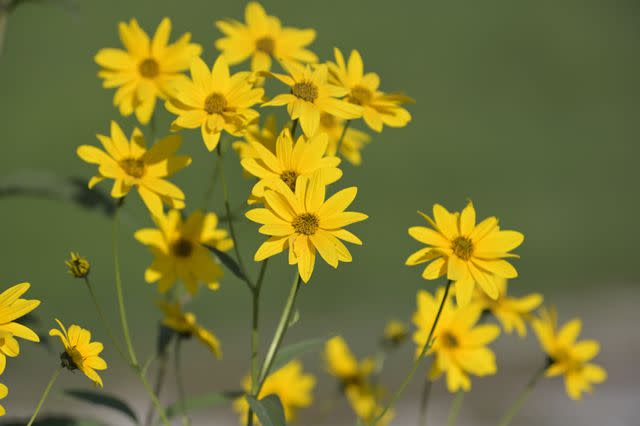
Getty Images /
Botanical Name: Helianthus angustifolia
Sun Exposure: Full Sun
Soil Type: Medium to Moist, Well-draining
Soil pH: Slightly Acidic to Neutral (5.6-7.3)
Narrowleaf sunflower is a beacon in the autumn garden. A profusion of sunny yellow blooms opens late in the season, primarily in the month of October. Blooms are followed by small seed heads that are a favorite of songbirds. This spectacular native reaches 5 to 8 feet tall, with fine textured foliage that makes a soft backdrop for shorter, earlier blooming species.
Autumn Sage
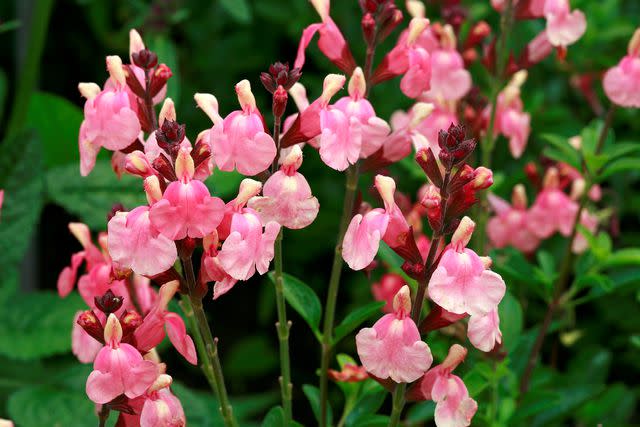
Getty Images / REDA&CO
Botanical Name: Salvia greggii
Sun Exposure: Full Sun to Part Shade
Soil Type: Dry to Medium, Well-draining
Soil pH: Neutral to Slightly Alkaline (6.5-7.8)
Despite its name, autumn sage has a very long bloom season, flowering on and off from spring through fall. However, it is known and named for its wonderful late-season display. Numerous cultivars are available with a wide range of flower colors from pale yellow to orange, fuchsia to purple, red-violet, burgundy, and white. Autumn sage is adaptable to a range of soils and is quite tolerant of heat and drought. Plants grow two to three feet tall and wide, with an open canopy of small, aromatic leaves.
Rose Verbena
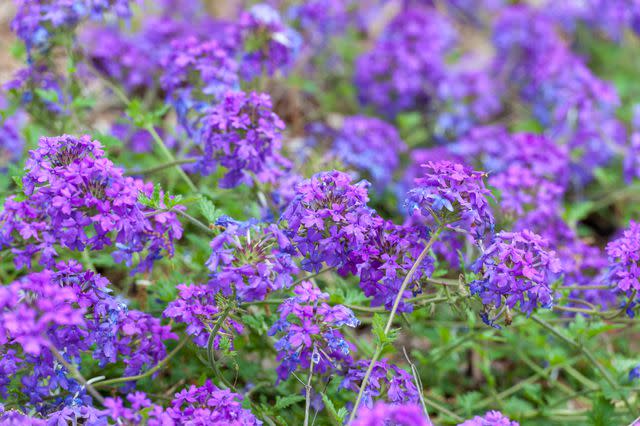
Getty Images
Botanical Name: Verbena canadensis
Sun Exposure: Full Sun
Soil Type: Dry to Medium, Well-draining, Average
Soil pH: Slightly Acidic to Slightly Alkaline (6.0-8.0)
Though rose verbena begins blooming as early as May, plants continue to flower well into fall, providing months of color. Clusters of showy pink, purple, or white flowers attract butterflies and hummingbirds to the garden. Plants grow in a low mound and will slowly spread by rooting at the nodes. Deadhead spent flowers to keep plants compact and flowering.
Red Spider Lily
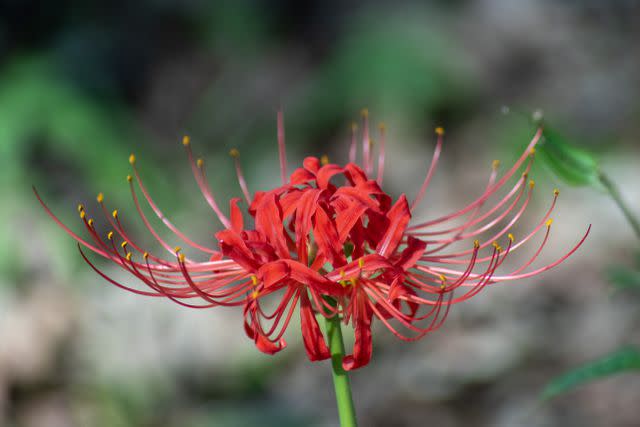
Getty Images / Jeremy Miller
Botanical Name: Lycoris radiata
Sun Exposure: Full Sun to Part Shade
Soil Type: Medium to Moist, Well-draining, Rich
Soil pH: Slightly Acidic to Slightly Alkaline (6.0-8.0)
Often called equinox flower, red spider lily blooms as the seasons shift, typically following the first autumn rains. The striking red blooms stand atop tall stems rising one to two feet from the ground. Each flower stalk contains four to six two-inch blooms, arranged in a spoke. Flowers have long stamens that give the blooms a spidery-like appearance. Foliage emerges after the flowers fade and persists throughout the winter. Spider lilies look most at home emerging through a low groundcover.
Great Blue Lobelia
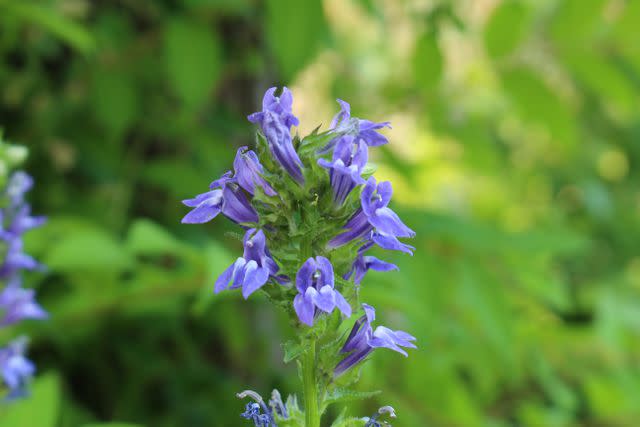
Getty Images
Botanical Name: Lobelia siphilitica
Sun Exposure: Full Sun to Part Shade
Soil Type: Medium to Wet, Well-draining, Rich
Soil pH: Slightly Acidic to Slightly Alkaline (6.0-8.0)
Flowering late summer through early fall, this relative of cardinal flower produces light to dark blue tubular flowers that attract hummingbirds and butterflies. Blooms are produced on spikes standing up to three feet tall. Great blue lobelia tolerates deep shade and wet soils, making a wonderful addition to shady rain gardens, damp meadows, and woodland gardens.
Toad Lily
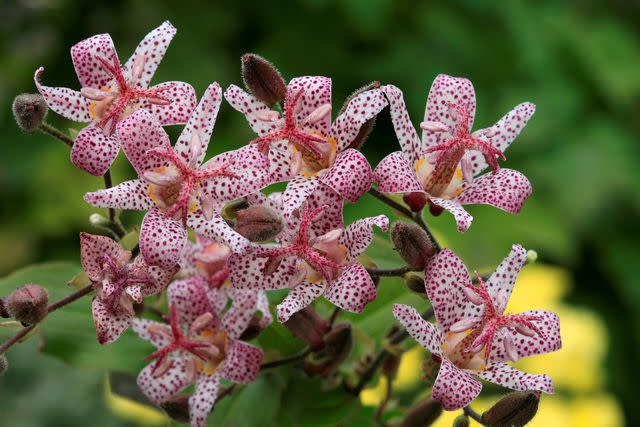
Getty Images / REDA&CO
Botanical Name: Tricyrtis hirta
Sun Exposure: Full to Part Shade
Soil Type: Moist, Well-draining, Rich
Soil pH: Slightly Acidic to Neutral (5.6-7.5)
The orchid-like blooms of toad lily are sure to impress with their exotic charm. Plant this garden jewel close to paths where you can admire the unique white to lavender blooms bedazzled with rich purple speckles. Attractive foliage is held on arching stems in a ladder-like arrangement. Toad lilies tolerate deep shade and make a lovely addition to woodland gardens.
Sneezeweed
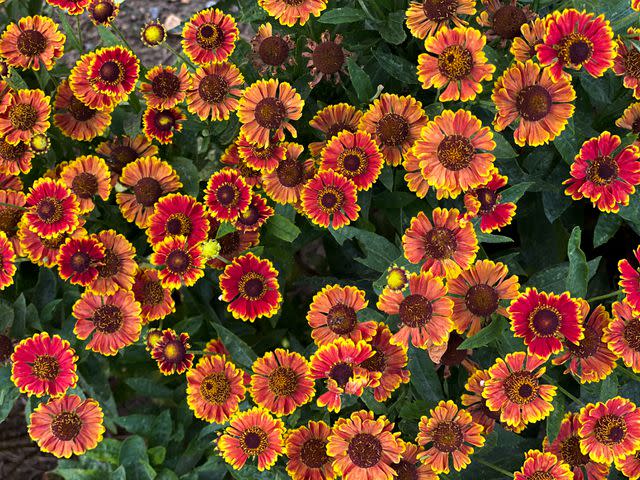
Getty Images / Catherine McQueen
Botanical Name: Helenium autumnale
Sun Exposure: Full Sun to Part Shade
Soil Type: Medium to Wet, Well-draining, Average to Rich
Soil pH: Slightly Acidic to Neutral (5.5-7.0)
Sneezeweed might have an unappealing name, but rest assured, this native beauty does not cause allergies. With an abundance of cheerful blooms in shades of gold, orange, and red, sneezeweed is certainly worthy of space in the fall garden. Look for one of the many cultivars of sneezeweed, which have showier blooms than the straight species and attract a bounty of pollinators. Cut plants back in early summer to encourage branching and increased blooming.
'Autumn Joy' Sedum
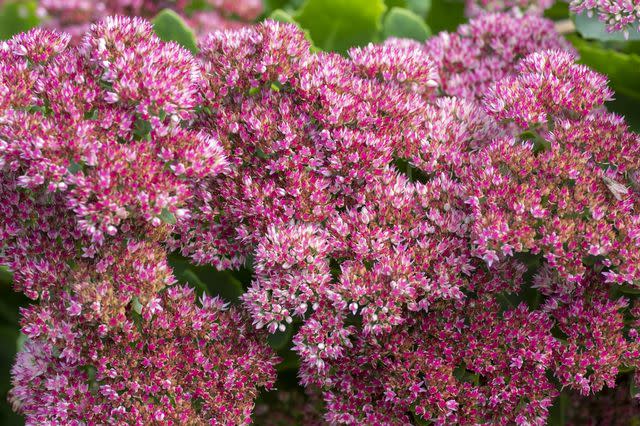
Getty Images / Iva Vagnerova
Botanical Name: Hylotelephium hybrid 'Herbstfreude'
Sun Exposure: Full Sun
Soil Type: Dry to Medium, Well-draining, Low to Average Fertility
Soil pH: Neutral to Slightly Alkaline (6.6-7.8)
'Autumn Joy' sedum has long been a favorite of the fall garden. With pink flower buds opening to deep rose-red flower heads, 'Autumn Joy' provides a valuable late-season source of nectar to bees and butterflies. This drought-tolerant succulent thrives in a variety of settings, from shallow, rocky outcrops to clay soil. Cut or pinch plants back in early spring to maintain a bushier habit and encourage thick stems.
'Fireworks' Goldenrod
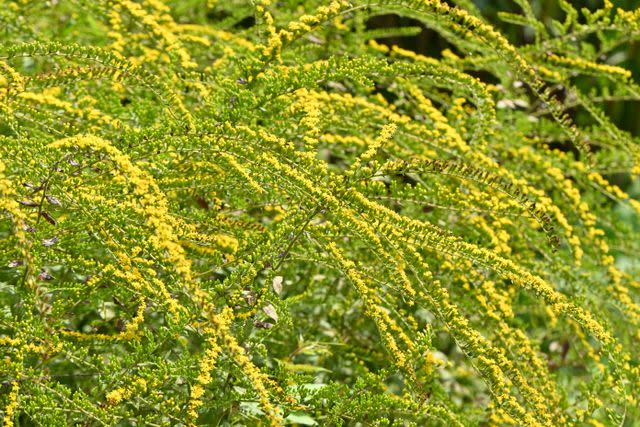
Getty Images
Botanical Name: Solidago rugosa 'Fireworks'
Sun Exposure: Full Sun
Soil Type: Medium to Wet, Well-draining, Average Fertility
Soil pH: Slightly Acidic to Neutral (5.5-7.0)
Goldenrods are adored for their autumn blooms, that echo the hues of fall foliage. 'Fireworks' is a variety of rough-leaf goldenrod with blooms flowing like a fountain of gold along gracefully arcing stems held above the foliage. The display is unique among goldenrods and quite stunning. The flowers attract butterflies, bees, and other pollinators. Plants tolerate both dry and wet soils and spread slowly by rhizomes. Divide plants every three to four years.
Autumn Crocus
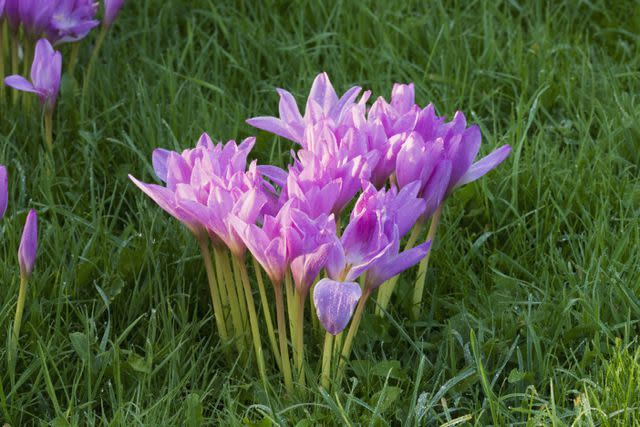
Getty Images / Clive Nichols
Botanical Name: Colchicum autumnale
Sun Exposure: Full Sun to Part Shade
Soil Type: Medium to Moist, Well-draining, Rich
Soil pH: Acidic to Neutral (4.5-7.5)
Autumn crocus produces lavender-pink flowers resembling the spring-blooming bulbs for which they are named. The large, lily-like flowers arise naked—that is, without the accompaniment of foliage—in early fall. Foliage emerges separately in spring. Autumn crocus performs well in rock gardens, where they benefit from good drainage. Avoid planting colchicum in locations where they will be covered by falling leaves in autumn.
Pink Muhly Grass
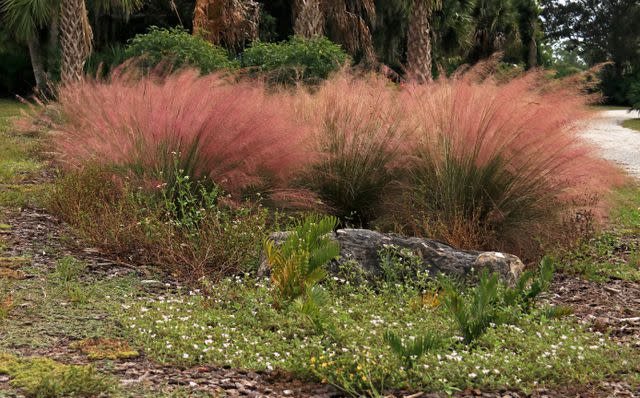
Getty Images / Zen Rial
Botanical Name: Muhlenbergia capillaris
Sun Exposure: Full Sun to Part Shade
Soil Type: Dry to Medium, Well-draining
Soil pH: Slightly Acidic to Neutral (5.5-7.0)
With masses of airy pink plumes, this ornamental grass deserves a place among fall-blooming perennials flowers. The wispy flower heads of pink muhly grass hover like clouds above blue-green foliage, creating drifts of vibrant color unmatched in the landscape. Flowers are followed by tan seed heads that hold through winter, offering food for birds. Drought tolerant and deer resistant, pink muhly grass also tolerates salt and is ideal for coastal environments as well as dry interiors.
Blue Mistflower
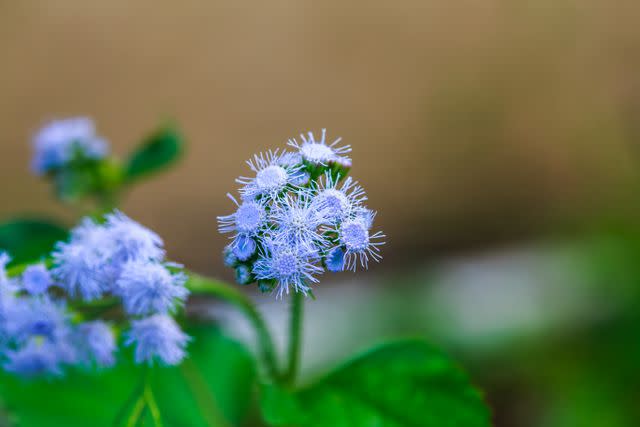
Getty Images / Wirestock
Botanical Name: Conoclinium coelestinum
Sun Exposure: Full Sun to Part Shade
Soil Type: Moist, Well-draining, Rich
Soil pH: Slightly Acidic to Neutral (6.0-7.0)
This showy native plant produces clusters of fluffy, purple-blue flowers adored by butterflies. It is perfect for naturalizing in meadows, along pond edges, and other areas where plants can be allowed to spread by rhizome and self-seeding. Blue mistflower blooms over a long season, providing eight weeks of color from late summer until frost. Birds enjoy the seeds that follow the blooms.
For more Southern Living news, make sure to sign up for our newsletter!
Read the original article on Southern Living.

